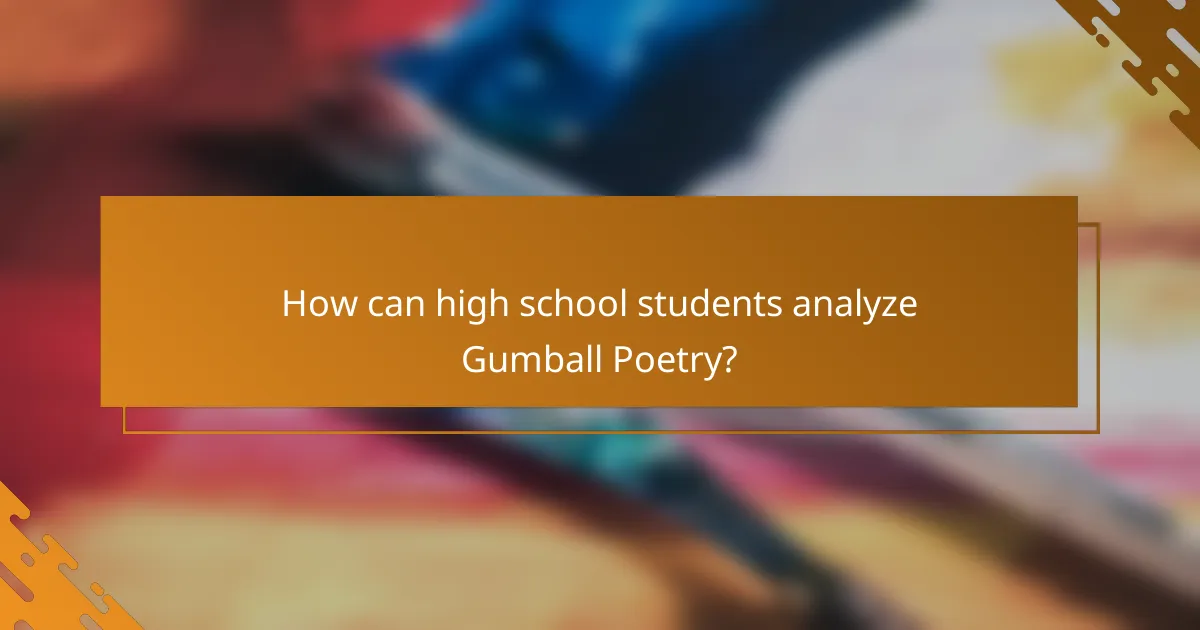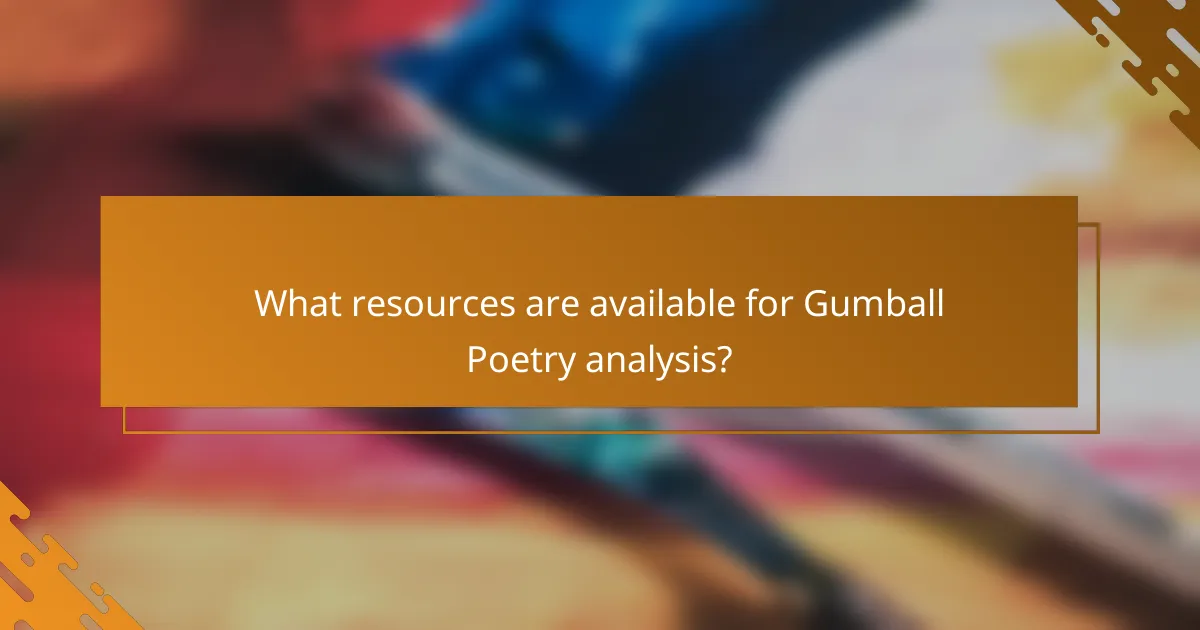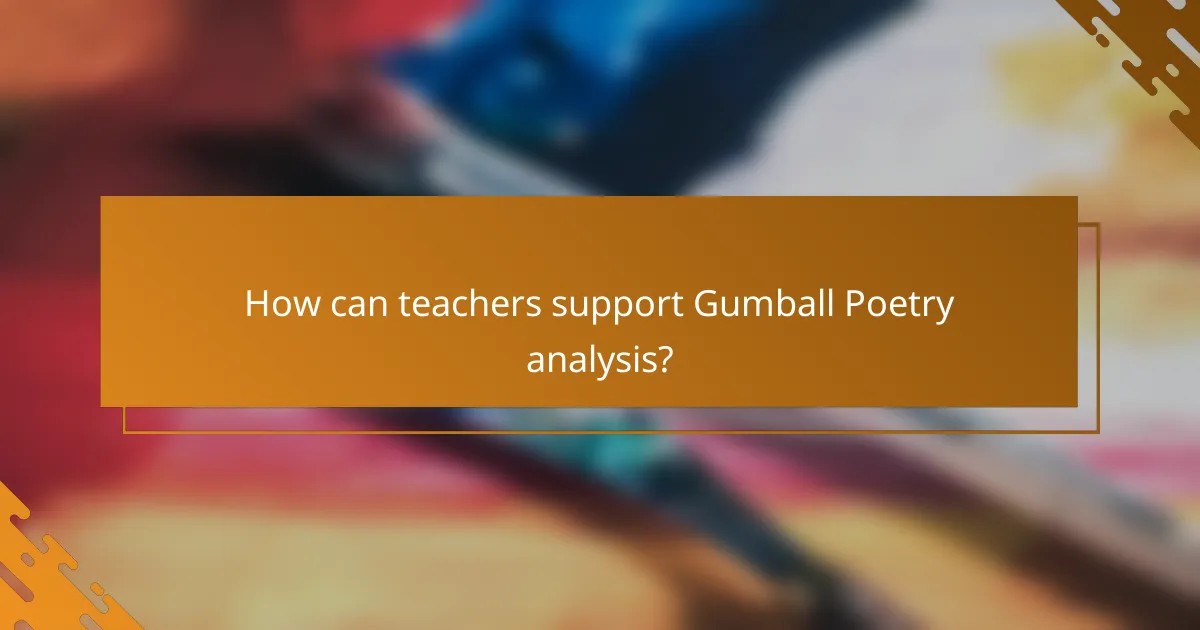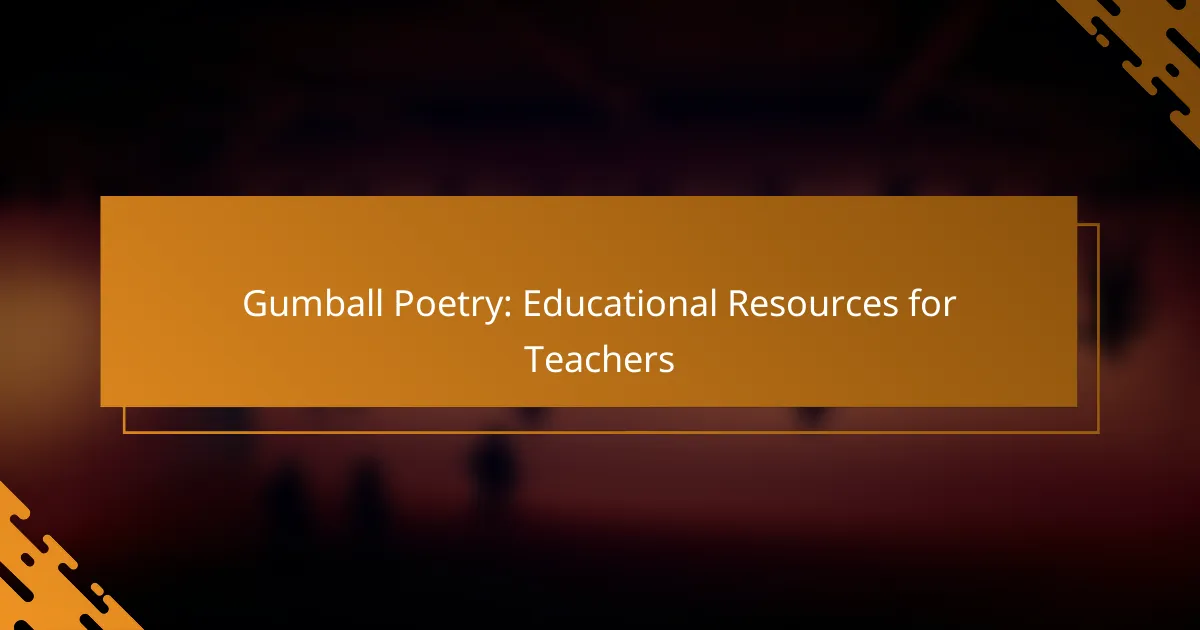Gumball Poetry offers a rich landscape for high school students to explore through various analysis techniques. By examining themes, structure, and figurative language, students can uncover the emotional depth and intent behind the poems. Engaging in close reading, comparative analysis, and group discussions further enhances their appreciation and understanding of this unique poetic form.

How can high school students analyze Gumball Poetry?
High school students can analyze Gumball Poetry by focusing on its themes, structure, figurative language, emotional impact, and authorial intent. This multifaceted approach allows for a deeper understanding of the poem’s meaning and artistic expression.
Identify themes and motifs
Identifying themes and motifs is crucial in Gumball Poetry, as these elements convey the underlying messages and ideas. Common themes might include childhood, nostalgia, or the passage of time. Students should look for recurring images or concepts that highlight these themes throughout the poem.
To effectively identify motifs, consider creating a list of repeated symbols or phrases. For example, if the poem frequently mentions colors or specific objects, these may serve as motifs that enhance the overall theme.
Examine structure and form
The structure and form of Gumball Poetry play a significant role in its impact. Students should analyze the poem’s layout, including line breaks, stanza organization, and overall length. These elements can influence how the poem is read and interpreted.
For instance, a poem with short, fragmented lines may evoke feelings of urgency or chaos, while longer, flowing lines might create a sense of calm. Pay attention to how the form complements the poem’s themes and emotional tone.
Interpret figurative language
Figurative language enriches Gumball Poetry, providing layers of meaning through devices like metaphors, similes, and personification. Students should identify these elements and consider how they contribute to the poem’s overall message.
For example, if a poet uses a metaphor to compare life to a gumball machine, it may suggest themes of unpredictability and chance. Analyzing these comparisons helps uncover deeper insights into the poet’s intent.
Evaluate emotional impact
Evaluating the emotional impact of Gumball Poetry involves assessing how the poem resonates with readers. Students should reflect on their own feelings while reading and consider how specific words or images evoke those emotions.
To gauge emotional impact, students can ask themselves questions like: What feelings does this poem inspire? Are there particular lines that stand out? This reflection can lead to a richer understanding of the poem’s effect on its audience.
Discuss authorial intent
Understanding authorial intent is essential for a comprehensive analysis of Gumball Poetry. Students should consider what the poet aims to communicate and how their background or experiences might influence their work. Researching the poet’s biography can provide valuable context.
Additionally, discussing the historical or cultural context in which the poem was written can shed light on the author’s choices. This exploration can help students appreciate the nuances of the poem and its relevance to contemporary issues.

What techniques enhance Gumball Poetry analysis?
Techniques that enhance Gumball Poetry analysis include close reading strategies, comparative analysis with other poetry forms, and engaging in group discussions for peer feedback. These methods help students deepen their understanding and appreciation of the unique qualities of Gumball Poetry.
Close reading strategies
Close reading involves carefully examining the text to uncover deeper meanings and nuances. Students should focus on specific word choices, imagery, and the structure of the poem, noting how these elements contribute to the overall theme. For example, analyzing the use of color imagery in a Gumball poem can reveal emotional undertones.
Encourage students to annotate the poem, highlighting key phrases and making notes in the margins. This practice not only aids comprehension but also fosters critical thinking as students consider why the poet made certain choices. A checklist of elements to focus on can include tone, rhythm, and figurative language.
Comparative analysis with other poetry
Comparative analysis allows students to draw connections between Gumball Poetry and other poetic forms, enhancing their understanding of its unique characteristics. For instance, comparing a Gumball poem to a traditional sonnet can highlight differences in structure and thematic focus, such as the use of playful language versus formal constraints.
Students can create a table to compare elements like themes, tone, and stylistic devices across different poems. This method not only broadens their perspective but also encourages them to appreciate the diversity within poetry. A simple comparison might involve examining how both forms address similar themes, such as childhood or nature, but through different lenses.
Group discussions and peer feedback
Group discussions and peer feedback are essential for fostering a collaborative learning environment. Students can share their interpretations of Gumball Poetry, allowing them to see multiple perspectives and refine their own analyses. This exchange of ideas often leads to richer insights and a deeper appreciation of the poem’s layers.
To facilitate effective discussions, set clear guidelines for respectful dialogue and encourage students to ask open-ended questions. Additionally, implementing peer feedback sessions can help students articulate their thoughts more clearly and receive constructive criticism on their interpretations. This practice not only enhances analytical skills but also builds confidence in their poetic insights.

What resources are available for Gumball Poetry analysis?
High school students can access various resources for Gumball Poetry analysis, including online databases, textbooks, and educational websites. These resources provide valuable insights and techniques to enhance understanding and interpretation of this unique poetic form.
Online literary databases
Online literary databases are essential for finding scholarly articles and critiques on Gumball Poetry. Platforms like JSTOR or Project MUSE offer access to a wide range of literary journals that analyze poetry, including specific studies on Gumball Poetry. Students should utilize search filters to narrow down results to relevant topics.
When using these databases, focus on peer-reviewed articles for credible information. Look for analysis that discusses themes, structure, and stylistic elements unique to Gumball Poetry to deepen your understanding.
Poetry analysis textbooks
Poetry analysis textbooks provide foundational knowledge and techniques for interpreting various poetic forms, including Gumball Poetry. Titles such as “The Poetry Toolkit” or “Reading Poetry” often include sections dedicated to unique styles, offering frameworks for analysis.
Students should look for textbooks that include exercises or examples specifically related to Gumball Poetry. These practical applications can help reinforce analytical skills and provide a structured approach to dissecting poems.
Educational websites and blogs
Educational websites and blogs are excellent resources for accessible information and analysis techniques related to Gumball Poetry. Websites like Poetry Foundation or Academy of American Poets often feature articles that break down poetic forms and provide examples of Gumball Poetry.
Blogs run by educators or poetry enthusiasts can offer personal insights and unique interpretations. Engaging with these platforms can also help students discover contemporary Gumball poets and their works, enriching their analysis with current examples.

How can teachers support Gumball Poetry analysis?
Teachers can support Gumball Poetry analysis by providing structured guidance and creative opportunities for students. This approach helps students engage deeply with the text and develop their analytical skills.
Provide guided reading questions
Guided reading questions can direct students’ focus and enhance their understanding of Gumball Poetry. These questions should encourage critical thinking about themes, imagery, and the emotional impact of the poems.
For example, ask students to consider how the use of color in a poem reflects its mood or message. Questions like “What emotions does this stanza evoke?” or “How does the structure influence your interpretation?” can lead to rich discussions.
Facilitate workshops on poetic devices
Workshops on poetic devices are essential for helping students identify and analyze the techniques used in Gumball Poetry. Focus on elements like metaphor, simile, and alliteration, which can enhance their appreciation of the craft.
Consider using examples from well-known Gumball poems to illustrate these devices. Activities could include group analyses where students present their findings on specific poems, fostering collaboration and deeper insight.
Encourage creative responses
Encouraging creative responses allows students to express their interpretations of Gumball Poetry in unique ways. This can include writing their own poems inspired by the style or creating visual art that represents the themes.
Provide a safe space for sharing these responses, as peer feedback can enhance learning. Consider organizing a poetry reading event where students can showcase their work, reinforcing their connection to the material and each other.

What are common challenges in analyzing Gumball Poetry?
Students often face difficulties in analyzing Gumball Poetry due to its abstract concepts, complex language, and the need to engage with diverse perspectives. These challenges can hinder their ability to fully appreciate and interpret the nuances of this unique poetic form.
Understanding abstract concepts
Gumball Poetry frequently employs abstract ideas that can be hard to grasp. Students should focus on identifying key themes and emotions expressed in the poems, as these often serve as the foundation for deeper understanding.
To tackle abstract concepts, students can create mind maps that connect different ideas within the poem. This visual representation can help clarify relationships and enhance comprehension.
Interpreting complex language
The language in Gumball Poetry can be intricate, featuring unique metaphors and unconventional syntax. Students should pay close attention to word choice and phrasing, as these elements contribute significantly to the poem’s meaning.
A practical tip is to break down complex lines into simpler parts. Analyzing each segment can reveal layers of meaning and help students appreciate the poet’s craft.
Engaging with diverse perspectives
Gumball Poetry often reflects a variety of viewpoints, which can be challenging for students to navigate. Engaging with these perspectives requires an open mind and a willingness to explore different interpretations.
Students can benefit from discussing their interpretations with peers, as this collaboration can uncover insights they may not have considered. Keeping a journal of different viewpoints can also help track evolving thoughts on the poems.

How does Gumball Poetry relate to contemporary issues?
Gumball Poetry connects to contemporary issues by using playful language and vivid imagery to address serious societal themes. This form of poetry often reflects current events, cultural shifts, and personal experiences, making it relevant and relatable for today’s audience.
Reflection of societal themes
Gumball Poetry serves as a mirror to societal themes, capturing the complexities of modern life. It often addresses issues such as identity, social justice, and environmental concerns, allowing poets to express their views in an accessible format.
For example, a poem might use the metaphor of a gumball machine to illustrate the randomness of opportunity in society, highlighting disparities in access to resources. This technique encourages readers to think critically about their surroundings and the challenges faced by different communities.
When analyzing Gumball Poetry, consider how the imagery and language choices reflect broader societal issues. Look for recurring motifs that resonate with current events or cultural conversations, as these can deepen the understanding of the poem’s message.



